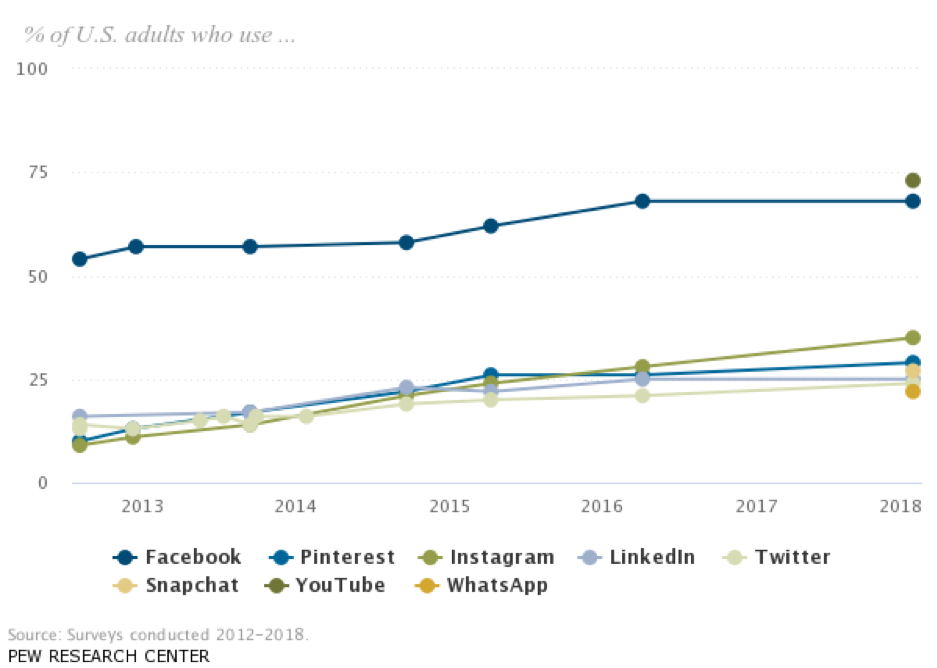Blog
Your Firm and Social Media - 2018 Insights
5/9/2018 11:30:00 AM

Different Approaches for Twitter and Facebook
It’s 2018, and social media for business can no longer be ignored.
Many of today's most prominent and content-driven social media platforms are now masterfully employed by a wide range of industries. These industries include retail, entertainment, technology, and many more. But, some professional service firms have neglected to follow suit.
With valid concerns regarding social media’s impact on both industry-specific regulations and client privacy, professional service firms -- from finance, to law, and beyond -- have continued to rely on time-tested and traditional tools for business promotion and networking. While referrals, direct mail, and firm prestige are unlikely to fall by the wayside as effective means for growth, the impact of social media in the digital age is clear - it has leveled the professional services playing field.
With more than 3 billion people around the world now using social media on a monthly basis, it has the potential to take traditional firm advertising/networking to unforeseen levels. In this respect, three distinct advantages relating to social media ROI come to mind:
- Credibility - i.e., showcasing your knowledge and expertise through videos, articles, and posts
- Discoverability - i.e., localizing your community and interacting with your stakeholders
- Client Acquisition - i.e., simultaneously generating multiple leads across distinct channels
Although the sheer number of social media platforms available for use may appear overwhelming given their differences in user base, culture, and applicability, Twitter and Facebook are the two platforms that currently reign supreme.
Facebook and Twitter: By the Numbers
It is important to note that most “Facebook vs. Twitter” literature is premised on the idea that the two behemoths of social media are industry rivals. While this is true, when it comes to their use by professional service firms, one is not necessarily better than the other. Both platforms offer unique advantages and disadvantages, and both platforms should be leveraged into a comprehensive social media strategy.
2018 Facebook Stats (Source: Hootsuite)
- There are 2.07 billion monthly active Facebook users (i.e., one-third of the world’s population)
- 77% of U.S. adults with at least some college education use Facebook
- The average U.S. adult spends 25.29 minutes per day on Facebook
- Business decision makers are twice as likely to be Facebook users than other individuals who use Facebook
- American’s in the $75,000+ income bracket have the highest Facebook adoption rate (76%)

2018 Twitter Stats (Source: Hootsuite)
- There are 330 million monthly active Twitter users
- Users send 500 million “tweets” each day (last updated in 2014)
- 21% of all U.S. adults use Twitter
- Twitter serves more than 2 billion search queries daily
- American’s in the $75,000+ income bracket have the highest Twitter usage rate (30%)
Facebook’s global reach far exceeds when compared to Twitter. However, this shouldn’t discourage professional service providers from using both, as social media is not a “one size fits all” tool. The main takeaway from this small sample size of statistics and data is that both platforms offer professional service firms a degree of diversity in selecting appropriate channels and fitting audiences.
Ultimately, it is the functionality of each platform (i.e., Twitter’s rapid-fire pace vs. Facebook’s permanence) that determines technique.
Ideas for Strategy and Approach
There are two fundamental differences between Facebook and Twitter, differences that are very likely to influence strategy and approach:
- Frequency of posting
- Longevity of each post
Facebook Strategy
Facebook, to put it plainly, is the place where social media users go to hang out.
It is a destination platform concerned with connecting individuals at the intersection of social and professional interests. As a more image, video, and article friendly platform, it is perfect for cultivating brand awareness and thought leadership. Firms can set up official pages and offer both current and prospective clients a unique look into the “why” and the “how” of the business. A well-crafted business page also provides relevant stakeholders the opportunity to engage firm leaders outside of formal business settings. Photos from the office and firm-related events (especially those focusing on community involvement) help to humanize leaders and provoke high levels of social media engagement.
As Facebook posts tend to remain relevant for longer, another technique for increasing engagement is to post industry-related content, including white papers, blog posts, and articles. A slower, more methodical posting schedule (i.e., 2-3 posts per day) can and should be supplemented by pay-per-click advertising. PPC advertising is rapid, cheap, customizable (age, gender, language, location, education, interests, etc.) and can help direct traffic towards a firm's official business page. In short, Facebook offers professional service firms the opportunity to demonstrate expertise in their industry.
Twitter Strategy
Moving to Twitter, we find this is the platform where social media users go to see what’s trending.
Information is published in 280 character-count posts and delivered to users in real time. It is either grouped into lists or followed by users through the hashtag (#) system. This intuitive method of categorization means that firms can employ Twitter as a means of starting industry-relevant conversations, or joining those conversations already trending. It is important to remember that Twitter users engage in 2 billion search queries each day. It is for this reason that users view it as an outlet for breaking news, rather than a platform for prolonged communication. Professional service providers may want to take a similar view and post accordingly.
Unlike Facebook posts, tweets occur more frequently, with greater concision, and in shorter succession. These factors typically result in a high level of client/prospective client engagement, but they also mean that tweets quickly lose relevance before disappearing down the memory hole. While this short lifespan may discourage firms focused on brand identity and thought leadership, it should not deter firms from tweeting links to articles, blog posts, and other relevant information within the scope of a holistic social media approach.
Key Takeaway
While inherently different in both form and functionality, Facebook and Twitter provide professional service firms with the tools necessary to acquire, engage, inform, and connect with a digital community of colleagues and clients.
Request a Proposal
If you are interested in any of our services, you can request a proposal by filling out the fields in this section.
CONTACT US
- Case Inquiry
- Media Contact
- 1-800-207-7160
- info@JNDLA.com
- www.JNDLA.com
- Careers@JNDLA.com
JOIN US